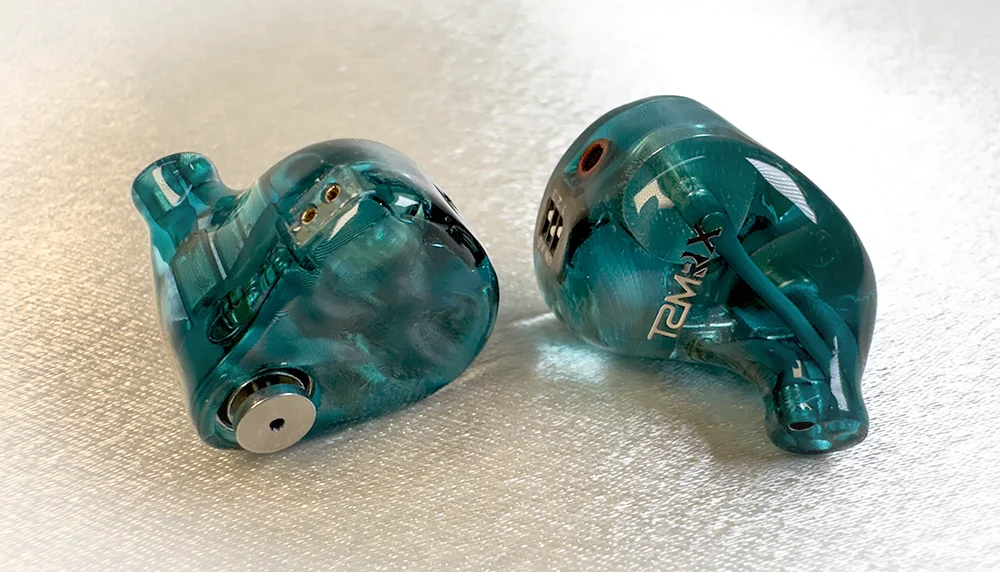Sound Impressions

I used a Luxury & Precision P6 Pro set to hi-gain mode at 8/60 volume to evaluate the Xs, as I listen at lower volumes. This is the Tidal playlist of tracks I use to evaluate IEMs.
The Xs boast 2x 8mm DDs for bass, 2x Knowles BAs for midrange and 2x Sonion BAs for treble and a “custom film retarding driver” for ‘full frequency effect’. The Xs are very bass dominant and slightly v-shaped with impressive technical performance & three switches to tune bass to your taste.
Bass
Impressive as the Xs’ other areas are, bass is no doubt their standout attribute. Even with the switches in default positions, bass reverberates spectacularly with overwhelming quantity & superb texture.
Those twin-DDs really pound out bass notes with aplomb, and better yet sub bass is emphasised over midbass which is definitely my preference. Sure the midrange is overshadowed to some degree, but with bass-heavy genres like EDM you’ll probably enjoy the bass way too much to care.
Bass texture is really meaty with tons of rumble, which is an area IEMs using single-DDs for bass have often satisfied me more than those with double-DDs, but the Xs are a notable exception!

Midrange
I’ve been pleasantly surprised by the Xs’ midrange. Despite this being their weakest area in terms of both quantity & quality of reproduction, Xs vocals are delivered with satisfying articulation & presence.
They’re set back slightly to help generate the feeling of a larger stage, but are definitely not recessed. Nor do they particularly suffer from poor tonality like those of many IEMs using BAs in this area, though I wouldn’t quote tonality as a strength either.
What helps is the balance between the lower & upper midrange is delicately poised, lacking the thickness of an IEM like the Quattros, yet avoiding the whispy upper-midrange focus of Harman-tuned IEMs.
Treble
I labeled the Xs as v-shaped earlier which is how I hear them, but despite being quite prominent treble is rarely excessive. Cymbals and the like come through distinctly, without being overly distracting.
As to the treble quality, it feels a small step down from expensive IEMs with EST drivers but about as good as you can expect under $500 from IEMs lacking huge numbers of BA drivers. I don’t mind living with little more treble than I’d prefer if the quality is agreeable, which is the case here.
Do bear in mind a lot of the extra treble seems to originate from the stock cable, so swapping it out for a copper alternative can dull this area if you’re very treble sensitive.
Technical Performance

The Xs are exceptional technical performers under $500 – particularly impressive given their enormous bass quantity, and that tonality hasn’t been sacrificed to achieve it.
To begin with they’re very dynamic, not the most dynamic IEM I’ve heard at this price (that’d be the Neo5s) but not far off either. Resolution is very good, particularly on tracks where that massive bass isn’t clouding the midrange. Sadly that also prevents imaging being top notch, but it’s quite solid.
They’re also very cohesive by hybrid standards, though the bass sometimes feels like it’s lagging a little purely because there’s so much of it – forgivable when bass texture is so satisfying I think.
Oh, and the soundstage. By the standards of IEMs under $500 it’s massive, especially width which is seriously impressive but even depth is very good. Overall I’m very pleased with the Xs’ technical chops.
Tuning Switches

The Xs feature three switches per side, which essentially allow you to control bass output.
Going from left to right, each switch triggers a higher level of bass quantity and flipping ON more than two at once simply triggers whichever setting is highest. So you’d flip Switch 1 to ON for max bass, or turn them all OFF for the most anaemic sound possible.
Switches in the stock position (shown above) activates the second-highest level of bass output which is very bassy, already overshadowing the midrange. Going to the max bass setting things get pretty crazy, enough bass to give me a headache – which admittedly will excite some of my basshead friends.
With all settings OFF nearly all bass is gone, which may work for classical music for maximum clarity.
Page 1 – Introduction, Packaging & Ergonomics
Page 2 – Sound Impressions, Technical Performance & Tuning Switches
Page 3 – IEM Comparisons
Page 4 – Cable Comparisons
Page 5 – Conclusion


Great review, thank you !